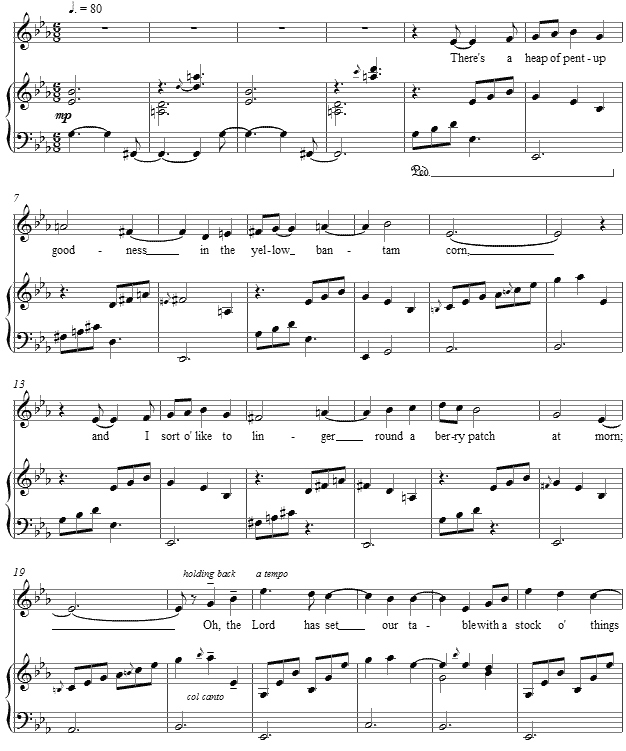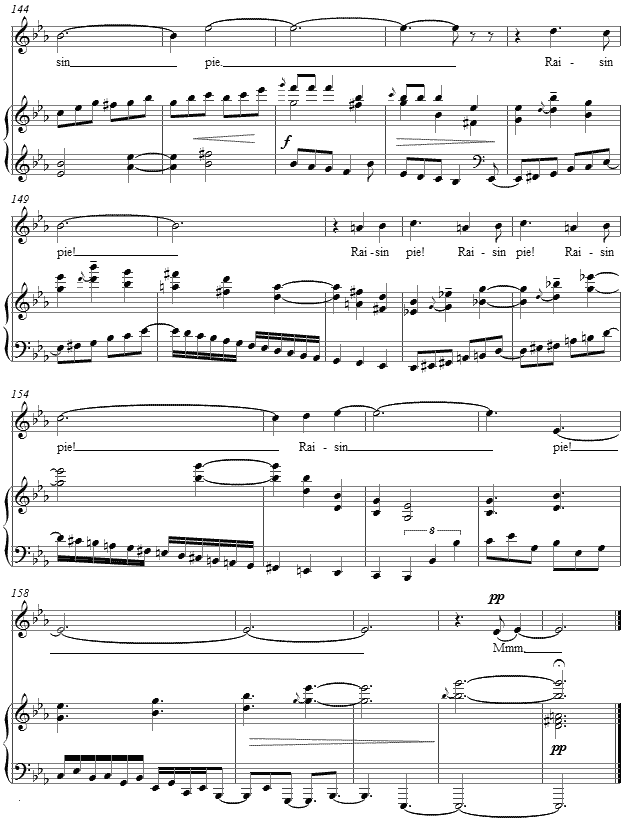Music and Texts of GARY BACHLUND
Vocal Music | Piano | Organ | Chamber Music | Orchestral | Articles and Commentary | Poems and Stories | Miscellany | FAQs
Raisin Pie - (2008)
Edgar Guest
for medium voice and piano
There's a heap of pent-up goodness in the yellow bantam corn,
And I sort o' like to linger round a berry patch at morn;
Oh, the Lord has set our table with a stock o' things to eat
An' there's just enough o' bitter in the blend to cut the sweet,
But I run the whole list over, an' it seems somehow that I
Find the keenest sort o' pleasure in a chunk o' raisin pie.
There are pies that start the water circulatin' in the mouth;
There are pies that wear the flavor of the warm an' sunny south;
Some with oriental spices spur the drowsy appetite
An' just fill a fellow's being with a thrill o' real delight;
But for downright solid goodness that comes drippin' from the sky
There is nothing quite the equal of a chunk o' raisin pie.
I'm admittin' tastes are diff'runt, I'm not settin' up myself
As the judge an' final critic of the good things on the shelf.
I'm sort o' payin' tribute to a simple joy on earth,
Sort o' feebly testifyin' to its lasting charm an' worth,
An' I'll hold to this conclusion till it comes my time to die,
That there's no dessert that's finer than a chunk o' raisin pie.[ 7 pages, circa 4' 10" ]
Edgar Guest
Born in Birmingham, England, Edgar Guest (1881-1959) was a naturalized American poet who was popular in the first half of the 20th century, known as the "People’s Poet." His family emigrated from the United Kingdom in 1891. He began work as a copy boy for the Detroit Free Press, working his way to being a reporter. From his first published work in the Detroit Free Press until his death in Detroit, Guest penned approximately 11,000 poems, syndicated in 300 newspapers and collected in 20 books, including A Heap o' Livin' (1916) and Just Folks (1917). He was named "Poet Laureate" of Michigan, with his popularity leading to a weekly Detroit radio show which he hosted from 1931 until 1942, followed by a 1951 NBC television series, A Guest in Your Home.
This musical setting of Guest's praise of raisin pie uses a fulcrum between E flat, the larger tonal frame, and D as one of its themes (as shown in the introduction), with the 6/8 meter shifting at times between the notated duple of 6/8 and triple of 3/4 time, its equivalent for this setting, a pattern which can be found at several levels rhythmically.
The second verse is set in D major, before a return to E flat for the final verse. The subdominant plays a more prominent role in this verse than in the first and last to heighten the sense of the middle verse as "bridge" material in this standard song form.
As the coda to the song, having emphasized the play between E flat and D, a rhapsodic downward left hand run contrasts one tonality against the other in a light polytonal manner, while the playful animosity between the duple and triple plays out rhythmically.
The score for Raisin Pie is available as a free PDF download, though any major commercial performance or recording of the work is prohibited without prior arrangement with the composer. Click on the graphic below for this piano-vocal score.
NOTES
Here is a little recipe for those who wish to make their own raisin pie.
Raisin Pie - a 19th century recipe
INGREDIENTS:
1 teacupful raisins (seeded and chopped)
1 cup sugar
1 lemon
1 cup boiling water
4 heaping teaspoons flour
butter, small piece
nutmeg, grated, to taste
pie crust
PREPARATION:
One teacupful of raisins (seeded and chopped), one cup of sugar, the juice of one good-sized lemon, one cup of boiling water; set this on stove; let come to a boil; then add four heaping teaspoonfuls of flour, wet in a little cold water; after it boils again, put in a small piece of butter and a little grated nutmeg; let cool before making into pies.
Doubling the amount, you can make three good-sized pies. The filling will keep for some time.
Attributed to Mrs. J. M. Davidson. Adapted from Recipes Tried and True, compiled by the Ladies' Aid Society of the First Presbyterian Church, Marion, Ohio, 1894, a source in the public domain.



